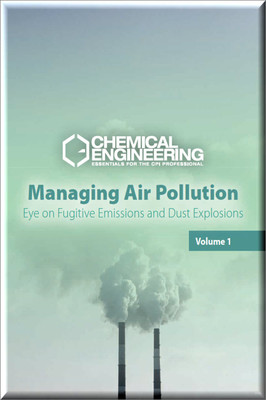Description
This Chemical Engineering guidebook contains tutorial-style engineering and “Facts at Your Fingertips” articles. Coverage includes strategies for minimizing fugitive emissions from valves, pumps, tanks, and piping systems through proper equipment selection, use of seals and gaskets, and operations and maintenance practices. Several articles also focus on reducing the risk of dust explosions—a critical safety concern in operations handling fine powders and bulk solids. The guidebook additionally addresses best practices for managing and modernizing plant revamps and capital-intensive projects.
Articles were originally published between 2010 and 2019. This is the first of a two-part series; Volume 2, entitled “Managing Air Pollution – Volume 2: Eye on Combustion and High-Temperature Operations,” is sold separately.
Features & Benefits
- Practical guidance on minimizing fugitive emissions from equipment and piping
- Techniques for reducing the risk of combustible dust explosions
- Best practices for plant revamps and modernization projects
- Insights on equipment selection, seals, gaskets, and maintenance strategies
- Coverage of air-pollution compliance and monitoring strategies
Audience
- Process engineers
- Safety engineers
- Maintenance managers
- Plant operators
- Technical managers in chemical and process industries
Articles Include
- Prevent Product Release with Pressure Protection Systems
- Key Considerations for the Use of Portable Gas Detectors
- Air-Pollution Control: Assessing the Options
- Controlling Dust through Pelletizing
- Designing Atmospheric Storage Tanks
- Dust Hazards
- Activated Carbon
- Clearing the Air About Respiratory Protection
- Common Mistakes When Conducting a HAZOP and How to Avoid Them
- Chemical Process Plants: Plan for Revamps
- Recent Air Regulations: Impact on Turnaround Vapor Deinventory Strategies
- Flow Measurement in Large Lines, Ducts, and Stacks
- Controlling SO2 Without Corroding the Bottom Line
- Cost Engineering: Equipment Purchase Costs
- Dust Control in the Chemical Processing Industries
- Project Optimization Through Engineering
- Things You Need to Know Before Using an Explosion-Protection Technique
- Activated Carbon: Fundamentals and New Applications
- Rupture Discs: Effectively Minimize Leaks and Emissions
- Containing Fugitive Emissions
- Measuring Exposures to Aerosols and Dust
- Efficiency in Pneumatic-Conveying Air Filters
- Minimizing Risk for Combustible Dust Explosions
- Technologies for Controlling H2S
- Global Air-Pollution Regulations: Variation is the Norm
- Prevent Combustible Dust Explosions with N2 Inerting
- Design and Calculation Methods for Uniflow Cyclones
- Piping-System Leak Detection and Monitoring for the CPI
- NFPA 652: Standardizing Combustible Dust Standards
- Dust Explosions: Prevention & Protection
- Safety in Sulfuric Acid Storage Tanks
- Dust Management in Bulk-Material-Handling Operations
- Powder and Bulk Solids Handling: Particle Size and Distribution Analysis
- Combustible Dust Fires and Explosions: Recent Data and Lessons Learned
- Forces Acting on a Gasket
- Industrial Adsorbents
- Emissions Regulations and Control
- Valves: Emissions Standards and Current Practices
- The Benefits of Seal-less Pumps for Full Product Containment
- Magnetically Coupled Pumps: Structure, Function and Best Practice
- Spill Containment: An Often-Overlooked Hazard in Research
- Odor Issues and Solutions for Wastewater Treatment
Details
Type: PDF
Pages: 220
FOR YOUR EYES ONLY: Please do not forward the PDF file. It is against the law to copy, fax, or electronically transmit the guidebook without permission.






